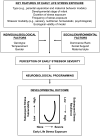Identifying key features of early stressful experiences that produce stress vulnerability and resilience in primates
- PMID: 20851145
- PMCID: PMC3023826
- DOI: 10.1016/j.neubiorev.2010.09.003
Identifying key features of early stressful experiences that produce stress vulnerability and resilience in primates
Abstract
This article examines the complex role of early stressful experiences in producing both vulnerability and resilience to later stress-related psychopathology in a variety of primate models of human development. Two types of models are reviewed: Parental Separation Models (e.g., isolate-rearing, peer-rearing, parental separations, and stress inoculation) and Maternal Behavior Models (e.g., foraging demands, variation in maternal style, and maternal abuse). Based on empirical evidence, it is argued that early life stress exposure does not increase adult vulnerability to stress-related psychopathology as a linear function, as is generally believed, but instead reflects a quadratic function. Features of early stress exposure including the type, duration, frequency, ecological validity, sensory modality, and developmental timing, within and between species, are identified to better understand how early stressful experiences alter neurobiological systems to produce such diverse developmental outcomes. This article concludes by identifying gaps in our current knowledge, providing directions for future research, and discussing the translational implications of these primate models for human development and psychopathology.
Copyright © 2010 Elsevier Ltd. All rights reserved.
Figures
Similar articles
-
Models of stress in nonhuman primates and their relevance for human psychopathology and endocrine dysfunction.ILAR J. 2014;55(2):347-60. doi: 10.1093/ilar/ilu023. ILAR J. 2014. PMID: 25225311 Free PMC article. Review.
-
The three-hit concept of vulnerability and resilience: toward understanding adaptation to early-life adversity outcome.Psychoneuroendocrinology. 2013 Sep;38(9):1858-73. doi: 10.1016/j.psyneuen.2013.06.008. Epub 2013 Jul 7. Psychoneuroendocrinology. 2013. PMID: 23838101 Free PMC article. Review.
-
Early-stress regulates resilience, vulnerability and experimental validity in laboratory rodents through mother-offspring hormonal transfer.Neurosci Biobehav Rev. 2011 Jun;35(7):1534-43. doi: 10.1016/j.neubiorev.2010.12.014. Epub 2011 Jan 7. Neurosci Biobehav Rev. 2011. PMID: 21216260
-
Early experience and depressive disorders: human and non-human primate studies.J Affect Disord. 2003 Jul;75(2):97-113. doi: 10.1016/s0165-0327(03)00046-6. J Affect Disord. 2003. PMID: 12798250 Review.
-
Adaptive significance of natural variations in maternal care in rats: a translational perspective.Neurosci Biobehav Rev. 2011 Jun;35(7):1552-61. doi: 10.1016/j.neubiorev.2011.03.012. Epub 2011 Mar 30. Neurosci Biobehav Rev. 2011. PMID: 21458485 Free PMC article.
Cited by
-
Moderate Childhood Stress Buffers Against Depressive Response to Proximal Stressors: A Multi-Wave Prospective Study of Early Adolescents.J Abnorm Child Psychol. 2015 Nov;43(8):1403-1413. doi: 10.1007/s10802-015-0021-z. J Abnorm Child Psychol. 2015. PMID: 25911194 Free PMC article.
-
Physiological and behavioural responses to weaning conflict in free-ranging primate infants.Anim Behav. 2014 Nov 1;97:241-247. doi: 10.1016/j.anbehav.2014.09.016. Anim Behav. 2014. PMID: 25431499 Free PMC article.
-
Maternal sensitivity and adrenocortical functioning across infancy and toddlerhood: Physiological adaptation to context?Dev Psychopathol. 2017 Feb;29(1):303-317. doi: 10.1017/S0954579416000158. Epub 2016 Apr 11. Dev Psychopathol. 2017. PMID: 27065311 Free PMC article.
-
Resilience in Children: Developmental Perspectives.Children (Basel). 2018 Jul 17;5(7):98. doi: 10.3390/children5070098. Children (Basel). 2018. PMID: 30018217 Free PMC article.
-
Sex-dependent effects of an early life treatment in rats that increases maternal care: vulnerability or resilience?Front Behav Neurosci. 2014 Feb 25;8:56. doi: 10.3389/fnbeh.2014.00056. eCollection 2014. Front Behav Neurosci. 2014. PMID: 24616673 Free PMC article.
References
-
- Agid O, Shapira B, Zislin J, Ritsner M, Hanin B, Murad H, et al. Environment and vulnerability to major psychiatric illness: a case control study of early parental loss in major depression, bipolar disorder and schizophrenia. Mol Psychiatry. 1999;4:163–172. - PubMed
-
- Anderson CO, Mason WA. Early experience and complexity of social organization in groups of young rhesus monkeys. J Comp Physiol Psychol. 1974;87:681–690.
-
- Anderson CO, Mason WA. Competitive social strategies in groups of deprived and experienced rhesus monkeys. Dev Psychobiol. 1978;11:289–299. - PubMed
-
- Andrews MW, Rosenblum LA. Attachment in monkey infants raised in variable- and low-demand environments. Child Dev. 1991;62:686–693. - PubMed
-
- Andrews MW, Rosenblum LA. The development of affiliative and agonistic social patterns in differentially reared monkeys. Child Dev. 1994;65:1398–1404. - PubMed
Publication types
MeSH terms
Grants and funding
LinkOut - more resources
Full Text Sources
Medical


